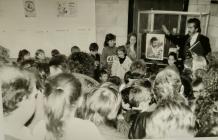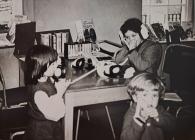Content can be downloaded for non-commercial purposes, such as for personal use or in educational resources.
For commercial purposes please contact the copyright holder directly.
Read more about the The Creative Archive Licence.
Description
Gwynedd Caernarfon’s panel has been completed using vintage colours reflecting the era in which it represents. The textured background incorporates a mixed media using different fabrics and
indicates the hardship of war time when people had to make do and mend. In contrast the felted poppies running down the banner symbolise the First World War.
In the top left hand corner is an iconic image in patchwork of Land Girl in a recruitment poster for the Women’s Land Army. The Women’s Land Army was organised by the Board of Agriculture during the Great War, starting its activities in 1915. With 3 million men away fighting in the First World War Britain was struggling for labour.
The government wanted women to get more involved in the production of food and do their part to support the war effort. Towards the end of 1917 there were over 250,000 - 260,000 women working as farm labourers, with 20,000 in the land army itself. Many years later in 1938 Lady Denman, the first Chair of the National Federation of Women’s Institutes, became the honorary director designate of the Women’s Land Army. She was the instigator of food production through the WI, recruiting women for the land army and said ‘every woman who can give a hand in the vastly important work of food production must give a hand’. The image of Lady Denman in quilting is the first of the portraits on the panel.
To the left of Lady Denman’s portrait is a collage of a wheelbarrow of vegetables in different textured materials, and seed packets and tools in machine embroidery, which would have been used by the Land Girls to grow their crops.
To the right of the panel is a knitted baby’s layette which represents the first clinic that was
introduced in Llanfairpwll in 1919 for expectant Mothers. Members produced special bags complete with everything for confinement including a baby’s layette which was given on loan and kept in readiness at the clinic by the WI.
Below the layette is an image transfer of the cover of the first copy of the WIs Home & Country
magazine launched in 1919. The founder editor of Home & Countrywas Miss Alice Williams and her portrait is the second quilted image on the panel. Alice Williams was the founder President of Deudraeth WI in Gwynedd Meirionnydd Federation where she gave her land and raised funds to build a hall for the institute, the first ever WI hall where meetings are still held today.
Using her considerable networks she invited Mrs Lloyd George to open it and arranged for the
members to receive a telegram of congratulations from Queen Mary. Alice Williams’ involvement with the WI was immense. She was elected as the first Honorary Secretary and Treasurer of the Central Committee of Management when the National Federation was formed in 1917 and continued to play a central, though changing, role in the WI throughout the 1920s and 1930s. Alice Williams was also a writer, specialising in poetry and verse commemorating special occasions.
In 1917 she became a member of the Gorsedd of the Bards at the National Eisteddfod of Wales, under the name of Alys Meirion; a great honour for a woman in those days.
The padded appliqué jam jars above the magazine refer to the allocation of rationed sugar that was
given to all WIs for organised jam making in 1917, 1918 and 1919.
The timeline running across the panel has been completed in cross-stitch and on it is the first WI badge which was proposed at a meeting in Llanfairpwll in 1916, this is also in cross-stitch. The words Fy Ngwlad Am Cartref mean For Home And Country.
Below the timeline to the right of the signpost which has been completed in cotton backed
with Bondaweb® is an image of Criccieth Castle. In front of the castle is a market stall in collage which symbolises the formation of the first WI Market in 1916 in Criccieth. Mrs Drage introduced the market for the marketing of home produce in response to the urgent need for increased food production and distribution. The stall is laden with produce and baskets of eggs which were sold at the market held twice a week at the WI room.
The embroidered federation badge features the Snowdon Lily (Lloydia Serotina) which Gwynedd
Caernarfon decided to adopt as their emblem. It is a very rare plant which flowers in a few secret places in Snowdonia.






Do you have information to add to this item? Please leave a comment
Comments (0)
You must be logged in to leave a comment